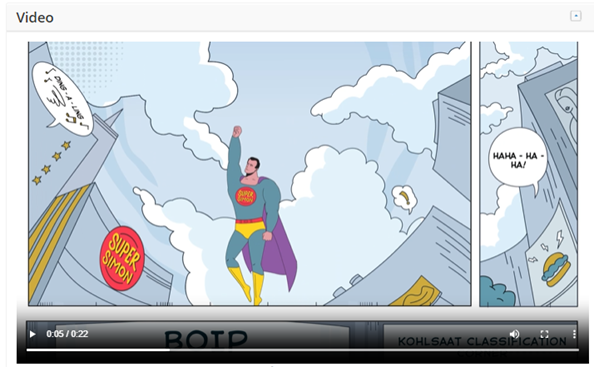August 11, 2023
Case Summary
A multimedia sign is a type of trademark which consists of or extends to sound and images.
On 7 May 2019, a Dutch company, Chiever B.V., filed EU Trade Mark Application No. 018061546 for a multimedia trade mark consisting of a 22-second comic book style video featuring the protagonist super-hero “Super Simon” flying from work to a holiday destination. The goods and services in the trade mark application consisted of books in Class 16, wine in Class 33 and entertainment and cultural services and performance of classical music in Class 41.

On 4 February 2020, the EUIPO refused the trade mark application on the basis that it was “devoid of any distinctive character” under Art. 7 (1)(b) of the EU Trade Mark Regulation (EUTMR). The Examiner considered that the mark simply intended to tell a story of the retirement in 2019 of outgoing Director of the Benelux Intellectual Property Office, Mr Edmon Simon. As such, it would not be distinctive or perceived as a badge of origin by consumers, particularly due to the following reasons:
- the complexity of the video;
- the clip did not contain any clearly perceptible goods and/or services;
- the origin of goods and/or services were not clearly included within the clip and there was an insufficient link with the goods and/or services (as would be the case in TV advertising).
Put simply, the original Examiner did not consider that it would function as a trade mark which is to indicate the origin of products or services.
On 7 March 2023, the EUIPO’s Board of Appeal overturned the Examiner’s refusal and found the trade mark to be distinctive. The decision acknowledged the lack of existing case law regarding multimedia trade marks and so provides useful clarification on the requirements to register a multimedia trade mark:
- There is no stricter requirement for registering multimedia trade marks. The Board found the same requirements apply to multimedia trade marks as traditional trade marks (e.g., word or logo marks). The multimedia mark does not need to show the owner in the sign or even the relevant goods and/or services.
- Multimedia marks are not synonymous with advertising. The fact a multimedia sign is a video does not mean it must be compared with advertising. The purpose of a trade mark is to guarantee the origin of goods and/or services and to distinguish them from the origin of other undertakings, whilst the purpose of advertising is to promote the sale of specific goods and/or services. Accordingly, the purpose of advertising is different, which is to provide as much information as possible to be informative (e.g., goods and/or services or the manufacturer / supplier).
- The modern consumer is accustomed to non-traditional trade marks. The digital evolution has changed the perception of consumers who are more accustomed to recognising non-traditional signs combining images and sounds as being distinctive when used as part of companies’ marketing strategies, and thereby considering them to be a badge of origin.
- The evolution of technology The Board in its decision also touched on the evolution of technology, which may be relevant to the rational for filing a multimedia trade mark, stating that it cannot be excluded that multimedia trade marks are capable of being placed on goods and that digital packaging is already a reality (e.g., ‘Super Simon’ may be used on wine in the form of a QR code on a label scanned by the consumer via a smartphone).
- The consumer does not have to remember the entirety of the trade mark. The Board found that if one element (sound or image) of the multimedia sign is distinctive, the whole multimedia sign will be distinctive. The length or complexity of the animation is irrelevant when deciding inherent registrability. The main character of the video “Super Simon” is distinctive, and the relevant public would remember the ‘general narrative’ that he flies away to a holiday. There is no requirement for the consumer to remember every detail of the sign, or even to remember a general narrative, but on this occasion it was helpful.
Takeaways from the Decision
This decision is good news for brand owners interested in exploring multimedia trade marks as a means of sustaining and protecting their brand presence in a digital world. It is particularly relevant for interactive entertainment and film & TV companies.
The EUIPO Board of Appeal has adopted a flexible approach in assessing the inherent distinctiveness of multimedia signs, recognising that consumers can perceive them as indicating origin, despite their complexity.
However, it will be interesting to see whether the same approach will be followed outside of the registry by the courts in the future, who may be more concerned about the public policy concerns around overlapping copyright and trade mark rights. In particular, the Board of Appeal’s guidance is very expansive and somewhat surprising given that it sits uncomfortably with the approach for other non-traditional trade marks. By way of comparison, the length of sound marks is a relevant factor which goes to whether or not the consumer will simply perceive it as a piece of music or as a badge of origin.
There are also open questions about the enforceability of multimedia trade marks and the scope of protection to which they will be entitled. Nevertheless, this decision opens the door to securing rights for longer and more complex multimedia marks, which could be a useful tool for brand owners operating in a digital world.
If you are interested in registering a multimedia trade mark, or would like to discuss the possibility of protecting any other non-traditional trade marks, please get in touch with our Intellectual Property team who will be happy to assist.
Expertise